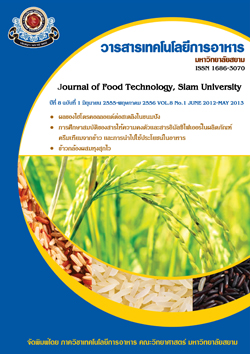Optimization of Xanthan Production with Xanthomonas campestris by Response Surface Methodology
Main Article Content
บทคัดย่อ
Xanthan gum, an important food additive, is used as a thickening agent and stabilizer in many food industrial applications. A 3-factor-3-level central composite rotatable design of response surface methodology was applied to model the fermentation parameters affecting xanthan production in a stirred tank bioreactor using Xanthomonas campestris TISTR 1100. The optimized production of xanthan gum was predicted and the interactive effects between fermentation parameters (yeast extract, fermentation time, and temperature) were investigated. Biomass concentrations, rheological property of fermentation broth and fermentation kinetics were evaluated and reported. Response surface analysis (RSM) showed that the data were adequately fitted to second-order polynomial model via quadratic regression relationship. The final mathematical model after eliminating the insignificant terms and refining the xanthan production was a quadratic model, xanthan yield = - 2.17 + 0.051 * fermentation+0.075 * temperature + 0.007 * fermentation * temperature - 0.002* fermentation2 with R2 = 0.965. RSM is an effective and useful method for optimizing the medium components and investigating the interactive effects, and can provide valuable information for xanthan scale-up fermentation using Xanthomonas campestris TISTR 1100.
Article Details
รูปแบบการอ้างอิง
Kongruang, S. (2015). Optimization of Xanthan Production with Xanthomonas campestris by Response Surface Methodology. วารสารเทคโนโลยีการอาหาร มหาวิทยาลัยสยาม, 8(1), 47–59. สืบค้น จาก https://li01.tci-thaijo.org/index.php/JFTSU/article/view/38429
ประเภทบทความ
บทความวิจัย (Research Articles)
บทความทุกบทความในวารสารเทคโนโลยีการอาหาร ทั้งในรูปแบบสิ่งพิมพ์ และในระบบออนไลน์ ถือเป็นลิขสิทธิ์ของมหาวิทยาลัยสยาม และได้รับการคุ้มครองตามกฎหมาย


